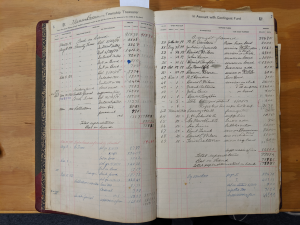What can tax records, clerk account books, property inventories, and voter registration records of a rural Michigan township tell us about human migration? Thanks to those who made efforts to preserve and restore the records of the Sugar Island township, we can learn a lot. A few months ago, I visited Sugar Island and Sault Ste. Marie, Michigan (pronounced “soo saint marie”) to dig through these recently rescued records from the 1910s-1940s in the collection of the Sugar Island History Preservation Society, housed by the Chippewa County Historical Society. Connie Pim, who did much of the rescuing, graciously made them available to HUMANA.
Sugar Island Community
Sugar Island, just south of the Canadian border, is surrounded by the St. Mary’s River, the waterway that connects Lake Superior to the rest of the Great Lakes. To visit the nearly 700 people living on Sugar Island’s 50 square miles, you have to catch a ferry that runs every half hour from Sault Ste. Marie, Michigan. Many of the residents are Anishinaabeg (and members of the large Sault Ste. Marie Tribe of Chippewa Indians). Their ancestors made Sugar Island and the surrounding region their home for thousands of years. Europeans began to disrupt life in the region in the late 1600s, but Finnish immigration to Michigan did not begin in earnest until the late 1800s.
 Sugar Island itself did not see many Finns until the early 1900s. Descendants of those Finns still live on Sugar Island. I visited Finn Hall, built on the island in the 1920s, which still stands thanks to the Sugar Island History Preservation Society. It was an important meeting place for the Finnish immigrants, but it also served as a community center for all Sugar Island residents, including Anishinaabeg families. Since restoration was completed several years ago, the old building has once again become a place to gather. I witnessed the preparations for the community rummage sell. Tables filled with knick-knacks lined Finn Hall, the funds for the sell would go to the Preservation Society.
Sugar Island itself did not see many Finns until the early 1900s. Descendants of those Finns still live on Sugar Island. I visited Finn Hall, built on the island in the 1920s, which still stands thanks to the Sugar Island History Preservation Society. It was an important meeting place for the Finnish immigrants, but it also served as a community center for all Sugar Island residents, including Anishinaabeg families. Since restoration was completed several years ago, the old building has once again become a place to gather. I witnessed the preparations for the community rummage sell. Tables filled with knick-knacks lined Finn Hall, the funds for the sell would go to the Preservation Society.
In the Archives
The purpose of my research trip was to digitize Sugar Island Township records relevant to our project. That work produced 5,400 images, each containing new pieces of information about the residents of Sugar Island living in the first four decades of the 20th century. Now that we have tax assessment rolls through much  of 1904-1940, voter registration rolls from 1918-1926 and 1935-1946, township clerk account books from 1917-1933, and miscellaneous correspondence and paperwork, we can gather much more data about who was living on Sugar Island, where they were from, where they settled, how much property they owned, what their occupations were, and to which organizations they belonged.
of 1904-1940, voter registration rolls from 1918-1926 and 1935-1946, township clerk account books from 1917-1933, and miscellaneous correspondence and paperwork, we can gather much more data about who was living on Sugar Island, where they were from, where they settled, how much property they owned, what their occupations were, and to which organizations they belonged.
Connie Pim also pointed me to a Works Progress Administration Property Inventory of Sugar Island that was completed in 1940. This giant report has incredibly detailed descriptions of land and housing (even information on the inside of homes – flooring, paint, etc.). Altogether, these Sugar Island Township records will give us the data necessary to analyze the communities of the island, the role of Finnish immigrants there, their social, political, and religious networks, and the patterns of migration and movement to and from Sugar Island, and much more. Saara and Olli are working to put all of this new data into digital datasets, which will be plugged into our network analysis software. These digital tools will get us a better understanding of the history of this unique island. We are excited about what we will learn.

Writer: Justin Gage
Keywords: Sugar Island, Finnish American history, historical network analysis
The public records I placed at the Chippewa County Historical Society for proper storage belong to Sugar Island Township, not Sugar Island Historical Preservation Society. This distinction is locally significant. —-I would observe that Sugar Islanders have had close ties to the nearby small city of Sault Ste. Marie that should be examined in detail as part of the Finnish immigrant experience. Wishing you well, Connie Pim
Dear Connie, thank you for your valuable comment and clarification! We were actually wondering how to properly cite these. We’ll make a correction to the blog and our article. Rani